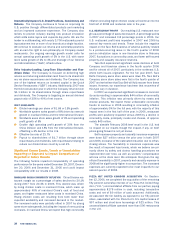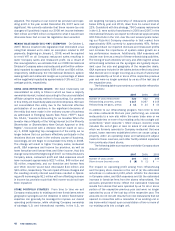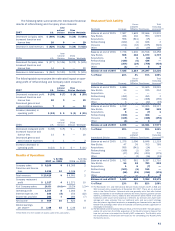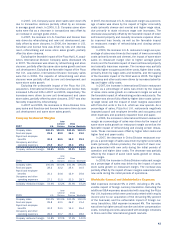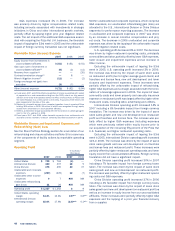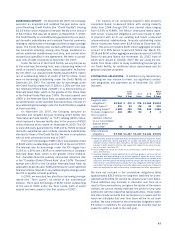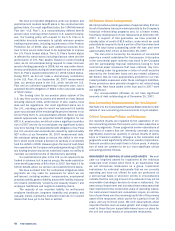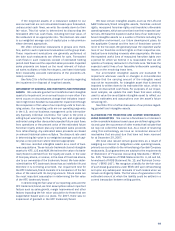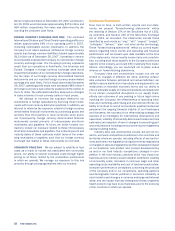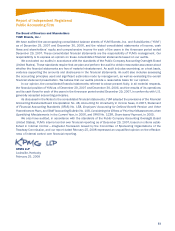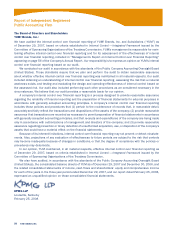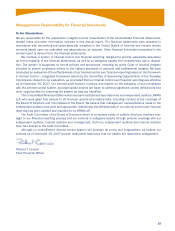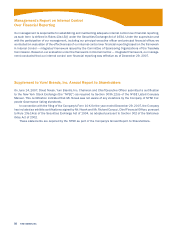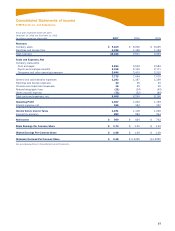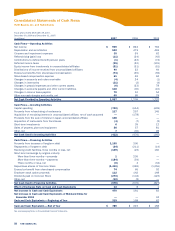Pizza Hut 2007 Annual Report Download - page 44
Download and view the complete annual report
Please find page 44 of the 2007 Pizza Hut annual report below. You can navigate through the pages in the report by either clicking on the pages listed below, or by using the keyword search tool below to find specific information within the annual report.48 YUM! BRANDS, INC.
We have not included obligations under our pension and
postretirement medical benefit plans in the contractual obli-
gations table. Our most significant plan, the YUM Retirement
Plan (the “U.S. Plan”), is a noncontributory defined benefit
pension plan covering certain full-time U.S. salaried employ-
ees. Our funding policy with respect to the U.S. Plan is to
contribute amounts necessary to satisfy minimum pension
funding requirements, including requirements of the Pension
Protection Act of 2006, plus such additional amounts from
time to time as are determined to be appropriate to improve
the U.S. Plan’s funded status. The U.S. Plan’s funded status
is affected by many factors including discount rates and the
performance of U.S. Plan assets. Based on current funding
rules, we do not anticipate being required to make minimum
pension funding payments in 2008, but we may make discre-
tionary contributions during the year based on our estimate of
the U.S. Plan’s expected December 27, 2008 funded status.
During 2007, we did not make a discretionary contribution
to the U.S. Plan. At our September 30, 2007 measurement
date, our pension plans in the U.S., which include the U.S.
Plan and an unfunded supplemental executive plan, had a
projected benefit obligation of $842 million and plan assets
of $732 million.
The funding rules for our pension plans outside of the
U.S. vary from country to country and depend on many factors
including discount rates, performance of plan assets, local
laws and tax regulations. Our most significant plans are in
the U.K., including a plan for which we assumed full liability
upon our purchase of the remaining fifty percent interest in our
former Pizza Hut U.K. unconsolidated affiliate. Since our plan
assets approximate our projected benefit obligation for our
KFC U.K. pension plan, we did not make a significant contribu-
tion in 2007 and we do not anticipate any significant further,
near term funding. The projected benefit obligation of our Pizza
Hut U.K. pension plan exceeds plan assets by approximately
$27 million at our November 30, 2007 measurement date.
We anticipate taking steps to reduce this deficit in the near
term, which could include a decision to partially or completely
fund the deficit in 2008. However, given the level of cash flows
from operations the Company anticipates generating in 2008,
any funding decision would not materially impact our ability to
maintain our planned levels of discretionary spending.
Our postretirement plan in the U.S. is not required to be
funded in advance, but is pay as you go. We made postretire-
ment benefit payments of $4 million in 2007. See Note 16 for
further details about our pension and postretirement plans.
We have excluded from the contractual obligations table
payments we may make for exposures for which we are
self-insured, including workers’ compensation, employment
practices liability, general liability, automobile liability and prop-
erty losses (collectively “property and casualty losses”) and
employee healthcare and long-term disability claims.
The majority of our recorded liability for self-insured
employee healthcare, long-term disability and property and
casualty losses represents estimated reserves for incurred
claims that have yet to be filed or settled.
Off-Balance Sheet Arrangements
We had provided a partial guarantee of approximately $12 mil-
lion of a franchisee loan pool related primarily to the Company’s
historical refranchising programs and, to a lesser extent,
franchisee development of new restaurants at December 29,
2007. In support of this guarantee, we have provided a
standby letter of credit of $18 million, under which we could
potentially be required to fund a portion of the franchisee loan
pool. The total loans outstanding under the loan pool were
approximately $62 million at December 29, 2007.
The loan pool is funded by the issuance of commercial
paper by a conduit established for that purpose. A disruption
in the commercial paper markets may result in the Company
and the participating financial institutions having to fund
commercial paper issuances that have matured. Any Com-
pany funding under its guarantee or letter of credit would be
secured by the franchisee loans and any related collateral.
We believe that we have appropriately provided for our esti-
mated probable exposures under these contingent liabilities.
These provisions were primarily charged to net refranchising
(gain) loss. New loans added to the loan pool in 2007 were
not significant.
Our unconsolidated affiliates do not have significant
amounts of debt outstanding as of December 29, 2007.
New Accounting Pronouncements Not Yet Adopted
See Note 2 to the Consolidated Financial Statements for further
details of new accounting pronouncements not yet adopted.
Critical Accounting Policies and Estimates
Our reported results are impacted by the application of cer-
tain accounting policies that require us to make subjective or
complex judgments. These judgments involve estimations of
the effect of matters that are inherently uncertain and may
significantly impact our quarterly or annual results of opera-
tions or financial condition. Changes in the estimates and
judgments could significantly affect our results of operations,
financial condition and cash flows in future years. A descrip-
tion of what we consider to be our most significant critical
accounting policies follows.
IMPAIRMENT OR DISPOSAL OF LONG-LIVED ASSETS We eval-
uate our long-lived assets for impairment at the individual
restaurant level except when there is an expectation that
we will refranchise restaurants as a group. Impairment
evaluations for individual restaurants that we are currently
operating and have not offered for sale are performed on
a semi-annual basis or whenever events or circumstances
indicate that the carrying amount of a restaurant may not be
recoverable (including a decision to close a restaurant). Our
semi-annual impairment test includes those restaurants that
have experienced two consecutive years of operating losses.
Our semi-annual impairment evaluations require an estima-
tion of cash flows over the remaining useful life of the primary
asset of the restaurant, which can be for a period of over 20
years, and any terminal value. We limit assumptions about
important factors such as sales growth and margin improve-
ment to those that are supportable based upon our plans for
the unit and actual results at comparable restaurants.


